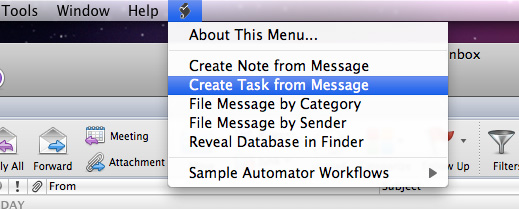Rules allow you to have incoming (or outgoing) messages sorted, filed, marked, or otherwise handled automatically.
- Outlook For Mac 2016 Set Applescript To Runes
- Outlook For Mac 2016 Set Applescript To Runner
- Outlook For Mac 2016 Set Applescript To Run
Outlook for Mac Signatures.scpt is an AppleScript that helps Mac SysAdmins with automating deployment of an HTML Mail Signature to Outlook for Mac 2016. Unfortunately we still can't perform a Central Push with this script, however using a Management tool to distribute the Mac Signature Tool, one can simplify the process significantly. Office 2016 for Mac license. If you choose to upgrade to Microsoft 365 or Office 2019 for Mac, you'll simply need to remove the existing Office 2016 for Mac license, but you won't need to remove your Office apps. Download and run the License Removal Tool.
We recommend that you use Outlook on the Web to create and manage your rules.
Why do we recommend Outlook on the Web?


Our Create Rules in Outlook on the Web article
The rest of this page is for those people who decide to set up their rules in Outlook 2016 for Mac anyway.
Rules are a way to have incoming (or outgoing) messages sorted, filed, marked, or otherwise handled automatically. You teach Outlook what to look for and what to do when it sees a message that meets the conditions you've set. For example:
- move messages from a particular address into a specified folder
- assign a category or flag to messages with a particular word in the subject
- forward all messages with attachments to another address
Here we'll talk about two ways to create rules:
Be aware that the order in which your rules are listed affects what happens. Notes on rule order below.
Creating a Rule Manually
- From the Tools menu choose Rules. A Rules dialog box will open.
- On the left, under Server Rules, click your account name (there may be only one account listed, and that's okay).
- Click the plus sign near the bottom of the dialog box. An Edit Rules dialog box will open.
- Give your rule a name (so you can find it later).
- Under When a new message arrives that meets all these conditions, use the drop-down lists to specify which messages meet the criteria for this rule. Start with the left-most drop-down list, as each selection determines the choices available in the other lists.
- If you have more than one criterion, click the plus sign at the right side of the criterion you just entered.
- Under Do the following, use the dropdown lists to set the action or actions you want taken on messages that match the criteria.
- If you have more than one action, click the plus sign at the right side of the action you just entered.
- If there are exceptions to the criteria, click the plus sign next to Except if, then use the drop-down lists to set the exception conditions.
- When finished defining the rule, click OK.
- Close the Rules dialog box.
Creating a Rule Based on a Message

Outlook For Mac 2016 Set Applescript To Runes

You can create a rule that will look for messages that look like one you've already received, rather than starting with a blank slate.
Outlook For Mac 2016 Set Applescript To Runner
First, select a message by highlighting it, then, in the Home ribbon, click Rules and select Create Rule.
The dialog box that opens will have three criteria pre-filled, based on the message you selected: From, Sent To, and Subject. Click the minus sign next to the conditions you do not want. You can also edit the conditions and the action as described in the Creating a Rule Manually section above.
Putting Your Rules in Order
Outlook For Mac 2016 Set Applescript To Run
The rules are checked in the order you have them listed. You can change the order of your rules by dragging and dropping them in the Rules dialog box.
The Do not apply other rules to messages that meet these criteria checkbox controls what happens when a message matches more than one rule. As a message is checked against each rule, the first time it matches a rule's criteria, Outlook looks at this checkbox on the rule that was matched.
- If the box is checked (which is the default), Outlook will stop checking rules on this particular message and go on to the next message.
- If the box is unchecked, Outlook will continue evaluating this message against the remaining rules.
Some actions automatically check the box AND gray it out so that you cannot uncheck it. If you Delete a message or Move it to a folder, the message is no longer available to be evaluated against the remaining rules. (If you Copy a message to a folder, this doesn't happen.)



